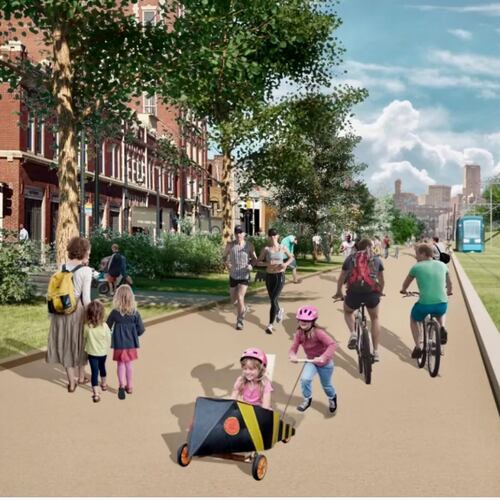Last year the Atlanta Regional Commission and a host of local communities and organizations around the Atlanta airport celebrated a nearly $65 million win.
The federal government awarded the group a grant to jump-start a 31-mile trail plan that would connect the Atlanta Beltline to East Point, Hapeville and College Park as well as communities along the Flint River south of Hartsfield-Jackson Atlanta International Airport.
The network would stretch through Clayton County, all the way to where Spalding and Pike counties meet.
Many think it could transform Atlanta’s south side, which has long seen a litany of disparities compared to the rest of the region. These include higher poverty rates, less economic investment, and less green space and trail mileage per capita.
The Trump administration’s “big beautiful bill” pulled that funding this summer. But the ARC and the communities behind the Flint River Gateway Trails have no plans of stopping.
“It’s still going to happen,” said Shannon James, CEO of Aerotropolis Atlanta.
His organization has been working on multiuse trail system ideas in the region for years, because they bring “organic” economic investment, he said, on top of improving quality of life.
“Our project was not some DEI project,” he said, referring to diversity, equity and inclusion programs that the Trump administration has broadly attempted to reverse. “We’ve watched how successful the Beltline has been. Now, our area is salivating for growth and development.”
The grant would have only funded construction of 3 trail miles and the planning work for nearly 11 more. The team got less than half what it had asked for.
Disappointment isn’t a strong enough word to describe how it felt to “literally have the funding slip through our fingertips,” East Point Mayor Deana Holiday Ingraham said.
But the ARC says it will continue moving the project forward by incrementally relying on its traditional federal and local government funding structure.
When ARC leadership told her that, Ingraham recalled saying, “Really?!”
“Knowing that we’re still going to be working together to get this transformative project done, is a lot,” she said.
The commission plans to hold meetings soon with stakeholders to keep that process going, said Mike Alexander, its COO.
The project is too important, and supporters have put in too much work to stop now, he said.
They’ll “methodically start to build this trail out over time, like the Beltline has been doing … for two decades,” Alexander said.
A long-term vision
The planning work behind the grant dates back about a decade, Alexander said.
Various south side communities, such as Hapeville and College Park, did their own studies for different sections of their own trail systems. East Point previously was rejected for its own smaller trail grant.
But a few years ago, Alexander and Josh Phillipson, an ARC program specialist who led the grant application, realized that if those dozen trail studies were plotted onto a map, they could quickly stitch together an entire network.
For those involved, this trail system is about so much more than just pavement.
It’s about righting historical wrongs: reconnecting communities disrupted by interstates and airport construction, rectifying trail access disparities, economically boosting the south side and restoring the Flint River.
“You’ve got over 1,000 miles in the (metro) region of trails and bike facilities, but so much of that is north of I-20,” said Eric Meyer, an active transportation planner with ARC.
“Aside from Peachtree City, the south side is underrepresented in having safe, comfortable facilities.”
Credit: Steve Schaefer
Credit: Steve Schaefer
The industrial development that has accompanied life around the world’s busiest airport hasn’t helped.
“There is a huge need for connectivity in our region,” James said. “Our region needs more trails. More walkability.”
This is an area “that has been severely impacted by the success of the airport,” as Phillipson put it.
“The airport is a huge success for Atlanta the region, but the negative impacts are borne disproportionately by the communities around it, under it,” he said. “This trail is an attempt to reconnect those communities.”
Part of the project involves reclaiming some of the site where the dirt for the fifth runway was sourced in Clayton County, Alexander noted.
The trail system also subsumes various projects identified by Finding the Flint, a nonprofit that has worked to identify and protect green space around the often-ignored river that runs beneath the airport.
Fusing the trails with the river restoration work “would be catalytic in a way that none of us had ever anticipated would even be possible,” said Stacy Funderburke, central southeast vice president for The Conservation Fund, which cofounded Finding the Flint and supported the grant application.
“If you go back to the heart of Finding the Flint, part of the issue is that no one even knew the river was there,” he said.
That would no longer be the case if a public trail system ran alongside it.
The Flint River has been “kind of sleeping asset we’ve never taken advantage of,” Hapeville Mayor Alan Hallman said.
Finding additional funding and moving forward with the trail system “is my dream.”
Credit: Atlanta Regional
Credit: Atlanta Regional
The plan forward
Even without the grant, portions of this trail system are still moving forward.
The Lee Street Trail, which connects the Westside Beltline trail to East Point is almost completely funded, Alexander said.
East Point is already constructing several miles of the network through its downtown. Clayton County is working on a portion of the proposed system along Tara Boulevard as well.
“Trails connect communities and actually help build a sense of community,” East Point Mayor Ingraham said.
But while the network has been identified, a lot more design work is still needed before ARC can estimate how much it all would cost — and how long it could take.
Having that $65 million “would have been a real catalytic amount to start with,” Phillipson said. “Doesn’t mean it doesn’t happen now, but it does stretch the time frame out quite a bit.”
“If anyone can pull it off,” Hallman added, “it would be the Atlanta Regional Commission.”
The fact that seven local governments and organizations partnered on the application — and several dozen more signed on in support — still has tremendous value, Phillipson said.
It got them coordinating, and it got everyone excited about the vision.
College Park Mayor Bianca Motley Broom said she “can’t recall a point at which (the south side has) been more united.”
“We’ve had a reputation of working in silos. This project and others show our focus and our commitment to moving forward as a region,” she said.
“Just because we get a setback doesn’t mean we quit.”
About the Author
Keep Reading
The Latest
Featured




